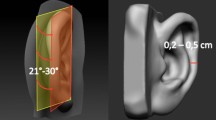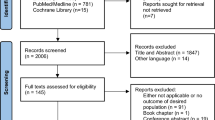Abstract
Introduction
Active middle ear implants (aMEI) are being increasingly used for hearing restoration in congenital aural atresia. The existing gradings used for CT findings do not meet the requirements for these implants. Some items are expendable, whereas other important imaging factors are missing. We aimed to create a new grading system that could describe the extent of the malformation and predict the viability and challenges of implanting an aMEI.
Methods
One hundred three malformed ears were evaluated using HRCT of the temporal bone. The qualitative items middle ear and mastoid pneumatization, oval window, stapes, round window, tegmen mastoideum displacement and facial nerve displacement were included. An anterior- and posterior round window corridor, oval window and stapes corridor were quantified and novelly included. They describe the size of the surgical field and the sight towards the windows.
Results
The ears were graded on a 16-point scale (16–13 easy, 12–9 moderate, 8–5 difficult, 4–0 high risk). The strength of agreement between the calculated score and the performed implantations was good. The comparison of the new 16-point scale with the Jahrsdoerfer score showed that both were able to conclusively detect the high-risk group; however, the new 16-point scale was able to further determine which malformed ears were favorable for aMEI, which the Jahrsdoerfer score could not do.
Conclusion
The Active Middle Ear Implant Score for aural atresia (aMEI score) allows more precise risk stratification and decision making regarding the implantation. The use of operative corridors seems to have significantly better prognostic accuracy than the Jahrsdoerfer score.








Similar content being viewed by others
Abbreviations
- aMEI:
-
Active middle ear implant
- EAC-A:
-
External ear canal atresia
- EAC-S:
-
External ear canal stenosis
- OW:
-
Oval window
- RW:
-
Round window
- R 2 :
-
Coefficient of determination
- VSB :
-
Vibrant Soundbridge™
References
Colletti V, Carner M, Sacchetto L, Colletti L, Giarbini N (2005) Round window stimulation with the Floating Mass Transducer: A new approach for surgical failures of mixed hearing losses. In: IFOS, Rome
Colletti V, Soli SD, Carner M, Colletti L (2006) Treatment of mixed hearing losses via implantation of a vibratory transducer on the round window. Int J Audiol 45(10):600–608
Colletti L, Carner M, Mandala M, Veronese S, Colletti V (2011) The floating mass transducer for external auditory canal and middle ear malformations. Otol Neurotol 32(1):108–115
Frenzel H, Hanke F, Beltrame M, Steffen A, Schonweiler R, Wollenberg B (2009) Application of the Vibrant Soundbridge to unilateral osseous atresia cases. Laryngoscope 119(1):67–74
Frenzel H, Hanke F, Beltrame M, Wollenberg B (2010) Application of the Vibrant Soundbridge in bilateral congenital atresia in toddlers. Acta Otolaryngol 130(8):966–970
Siegert R, Mattheis S, Kasic J (2007) Fully implantable hearing aids in patients with congenital auricular atresia. Laryngoscope 117(2):336–340
Verhaert N, Fuchsmann C, Tringali S, Lina-Granade G, Truy E (2011) Strategies of active middle ear implants for hearing rehabilitation in congenital aural atresia. Otol Neurotol 32(4):639–645
Wollenberg B, Beltrame M, Schonweiler R, Gehrking E, Nitsch S, Steffen A, Frenzel H (2007) Integration of the active middle ear implant Vibrant Soundbridge in total auricular reconstruction. HNO 55(5):349–356
Frenzel H, Schoenweiler R, Hanke F, Steffen A, Wollenberg B (2012) The Lübeck flowchart for functional and aesthetic rehabilitation of aural atresia and microtia. Otol Neurotol 33(8):1363–1367
Altmann F (1951) Malformations of the auricle and the external auditory meatus; a critical review. AMA Arch Otolaryngol 54(2):115–139
De la Cruz A, Linthicum FH Jr, Luxford WM (1985) Congenital atresia of the external auditory canal. Laryngoscope 95(4):421–427
Gill NW (1969) Congenital atresia of the ear. A review of the surgical findings in 83 cases. J Laryngol Otol 83(6):551–587
Jahrsdoerfer RA, Yeakley JW, Aguilar EA, Cole RR, Gray LC (1992) Grading system for the selection of patients with congenital aural atresia. Am J Otol 13(1):6–12
Oliver ER, Lambert PR, Rumboldt Z, Lee FS, Agarwal A (2010) Middle ear dimensions in congenital aural atresia and hearing outcomes after atresiaplasty. Otol Neurotol 31(6):946–953
Siegert R, Weerda H, Mayer T, Bruckmann H (1996) High resolution computerized tomography of middle ear abnormalities. Laryngorhinootologie 75(4):187–194
Teunissen EB, Cremers WR (1993) Classification of congenital middle ear anomalies. Report on 144 ears. Ann Otol Rhinol Laryngol 102(8 Pt 1):606–612
Yellon RF, Branstetter BF (2010) Prospective blinded study of computed tomography in congenital aural atresia. Int J Pediatr Otorhinolaryngol 74(11):1286–1291
Takegoshi H, Kaga K, Kikuchi S, Ito K (2002) Facial canal anatomy in patients with microtia: evaluation of the temporal bones with thin-section CT. Radiology 225(3):852–858
Mayer TE, Brueckmann H, Siegert R, Witt A, Weerda H (1997) High-resolution CT of the temporal bone in dysplasia of the auricle and external auditory canal. AJNR Am J Neuroradiol 18(1):53–65
Yeakley JW, Jahrsdoerfer RA (1996) CT evaluation of congenital aural atresia: what the radiologist and surgeon need to know. J Comput Assist Tomogr 20(5):724–731
Schlittgen R (2003) Einführung in die Statistik. Oldenbourg Wissenschaftsverlag
McKinnon BJ (2012) Anatomical considerations in aural atresia. Paper presented at the International Symposium on. Vibroplasty & Bone Conduction Implants, Hamburg
Osborn AJ, Oghalai JS, Vrabec JT (2011) Middle ear volume as an adjunct measure in congenital aural atresia. Int J Pediatr Otorhinolaryngol 75(7):910–914
Tasar M, Yetiser S, Yildirim D, Bozlar U, Tasar MA, Saglam M, Ugurel MS, Battal B, Ucoz T (2007) Preoperative evaluation of the congenital aural atresia on computed tomography; an analysis of the severity of the deformity of the middle ear and mastoid. Eur J Radiol 62(1):97–105
Conflict of interest
We declare that we have no conflict of interest.
Author information
Authors and Affiliations
Corresponding author
Rights and permissions
About this article
Cite this article
Frenzel, H., Sprinzl, G., Widmann, G. et al. Grading system for the selection of patients with congenital aural atresia for active middle ear implants. Neuroradiology 55, 895–911 (2013). https://doi.org/10.1007/s00234-013-1177-2
Received:
Accepted:
Published:
Issue Date:
DOI: https://doi.org/10.1007/s00234-013-1177-2




